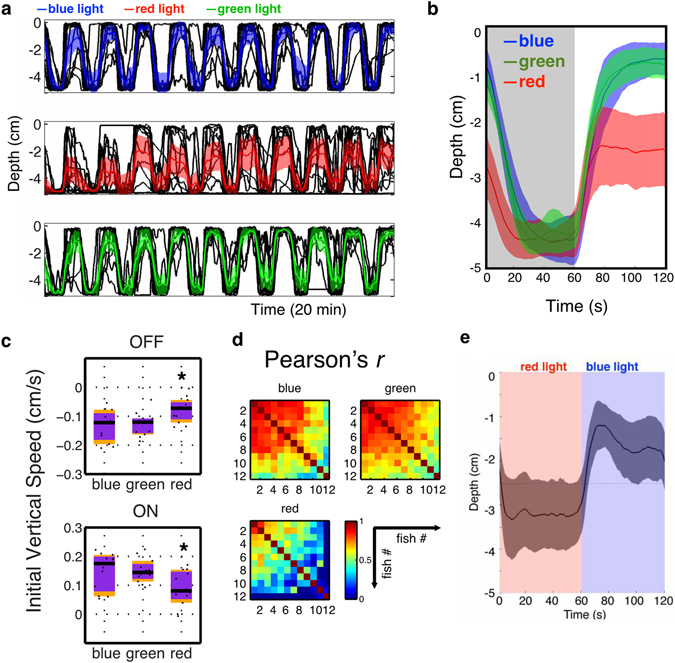Figure 3.

A comparison of vertical migration under blue, green and red light. (a) Vertical migration of larvae exposed to 10 cycles of blue (470 nm; 650 µW/cm2), green (525 nm; 580 µW/cm2) and red (660 nm; 465 µW/cm2) light, which yield the same photon intensity, ~1.56 × 1015 cm−2 s−1. Black lines represent individual fish, while colored traces represent the average. Shadows indicate 95% CIs. n = 12 for each group. (b) Mean vertical migration from 10 dark-light cycles, averaged from panel (a), represented as mean ± 95% CIs. (c) Comparisons of initial 20 s vertical swimming speeds. Vertical speeds under blue and green lights are similar (Diving: Mann-Whitney U = 66, p = 0.76, two tailed, rank-biserial correlation = 0.083; climbing: Mann-Whitney U = 68, p = 0.84, two tailed, rank-biserial correlation = 0.056). Vertical speeds under blue and red light are different (Diving: Mann-Whitney U = 31, *p = 0.0097, one tailed, rank-biserial correlation = 0.60; Climbing: Mann-Whitney U = 36, p = 0.040, two tailed, rank-biserial correlation = 0.50). Vertical speeds under green and red light are different (Diving: Mann-Whitney U = 30, p = 0.0083, one tailed, rank-biserial correlation = 0.58 Climbing: Mann-Whitney U = 34, p = 0.015, one tailed, rank-biserial correlation = 0.53). (d) Correlation coefficient of vertical position across time during 10 dark-light cycles. Correlation matrices are different (blue vs green: χ 2 = 3288, df = 66, p < 0.0001; blue vs red: χ 2 = 5534, df = 66, p < 0.0001. Jennrich’s χ 2 test). (e) Behavior under alternating red and blue light cycles with the same photon intensity ~1.56 × 1015 cm−2 s−1, represented as mean ± 95% CIs. Larvae display vertical migration, with the vertical position under blue light being higher than the vertical position under red light (Mann-Whitney U = 118, p = 0.008, two tailed, rank-biserial correlation = 0.64, n = 12).
